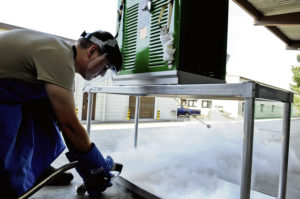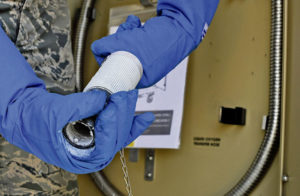


An Airman sits on the examination table, glancing at the medical posters and anatomical models as they wait under the harsh fluorescent lights for their doctor. After ripping the sheet underneath them to shreds, a nurse walks in and asks them a few questions about their medical history. Starting the process of figuring out how to return Airmen to the mission as efficiently and quickly as possible, the nurse says ‘say ahh.’
“That thermometer…is just the start of it,” said Tech. Sgt. Jonathan Cagle, 86th Medical Support Squadron noncommissioned officer in charge of war reserve materials maintenance. “As simple as a thermometer or a blood pressure unit may seem, it’s imperative that they are there and working correctly. If not, medical staff and technicians are basing their diagnosis off of wrong information, which could potentially harm a patient.”
Biomedical equipment technicians at Ramstein ensure their medical facilities have equipment that is functional. They perform basic electronic and troubleshooting diagnostics on every kind of medical equipment imaginable.
In the 86 MDSS, BMETs are stretched across several proficiencies in one work center: War Reserve Materials, Medical Equipment Repair Center, Patient Movement Items, and the clinics.
The WRM team works hand-in-hand with the medical logistics flight, which are responsible for the maintenance and inventory of medical equipment and supplies, as well as preparing for exercises, at the Air Force’s third largest and most active WRM to maintain 128 unit-type code assemblages worth more than $29 million.
The Ramstein BMETs team supported recent exercises such as Juniper Falcon, a U.S. Air Forces in Europe-led exercise in Israel; Flaming Sword, a Lithuanian-led NATO special operations forces exercise; and Saber Strike, a U.S. Army Europe-led exercise in Lithuania.
“Whether it’s for a deployment or exercise, we take the inspection and calibration of every piece of equipment item in those packages very seriously,” Cagle said.
At Ramstein, BMETs have the opportunity to be a part of a unique mission named ‘BMETs without Borders,’ traveling as a MERC team to 14 different countries across Europe, Africa, and Southwest Asia.
The 86 MDSS calibrates and repairs medical equipment while offering training to other BMETs who might not have the expertise or test equipment required to work on more complicated items like X-Ray, ventilators, or anesthesia equipment.
“We are the only MERC in USAFE, traveling to make sure that other BMETs have the tools and information they need to get the job done,” said Master Sgt. Travis K. Edwards, 86 MDSS clinical engineering superintendent.
In addition to taking care of almost 1,700 medical equipment items for the 86th Medical Group clinics, which includes the largest outpatient clinic in the Air Force and the largest dental clinic in Europe, the innovative BMETs at Ramstein have also found a way to use their own liquid oxygen generator and nitrogen.
War Reserve Material BMETs are producing next-generation portable therapeutic liquid oxygen units used on aeromedical evacuation missions to provide breathable oxygen to patients. Servicing these units requires coordination with several flight line entities to deal with both the liquid oxygen and the nitrogen portions of the process, which could take up to four weeks for the completion of just one unit.
By using their own materials, the entire maintenance process changed, effectively cutting the four-week process down to just three days.
“We are always looking for better, faster, and more efficient ways of doing things,” Edwards said. “Ramstein is the first base to be using this process and we are working to spread the procedure Air Force wide.”
Ramstein’s BMETs are very aware of the responsibility they hold for the safety and health of their customers, the patient movement items hub managing 1,300 life safety items worth more than $11.6 million for aeromedical evacuation missions throughout Africa, Southwest Asia, and Europe.
“Personally, my wife has needed multiple surgeries since I’ve been in the military,” Cagle said. “Seeing that same equipment that I myself worked on and calibrated taking care of her really brings it into perspective for me.”
With such important work to be done, BMETs have their work cut out for them.
“We’ve had a saying about quality over quantity,” Cagle said. “We don’t want to shortfall anything, but we have to make sure that the quality is there and it has to be done right, there’s no exception to that. If it’s not right, it ain’t done.”


